After battling finicky allium, ramp, and delphinium seeds this year, I was thrilled when it was time to turn my eye to planting borage.
Borage is one of those plants that makes me feel like I am a world champion green-thumb.
Whether I start them from seed or grab a few starts at the local farm, they seem to thrive no matter how neglectful I am.
That should tell you that if you’re thinking of starting some borage from seed, you don’t have a difficult task ahead of you.
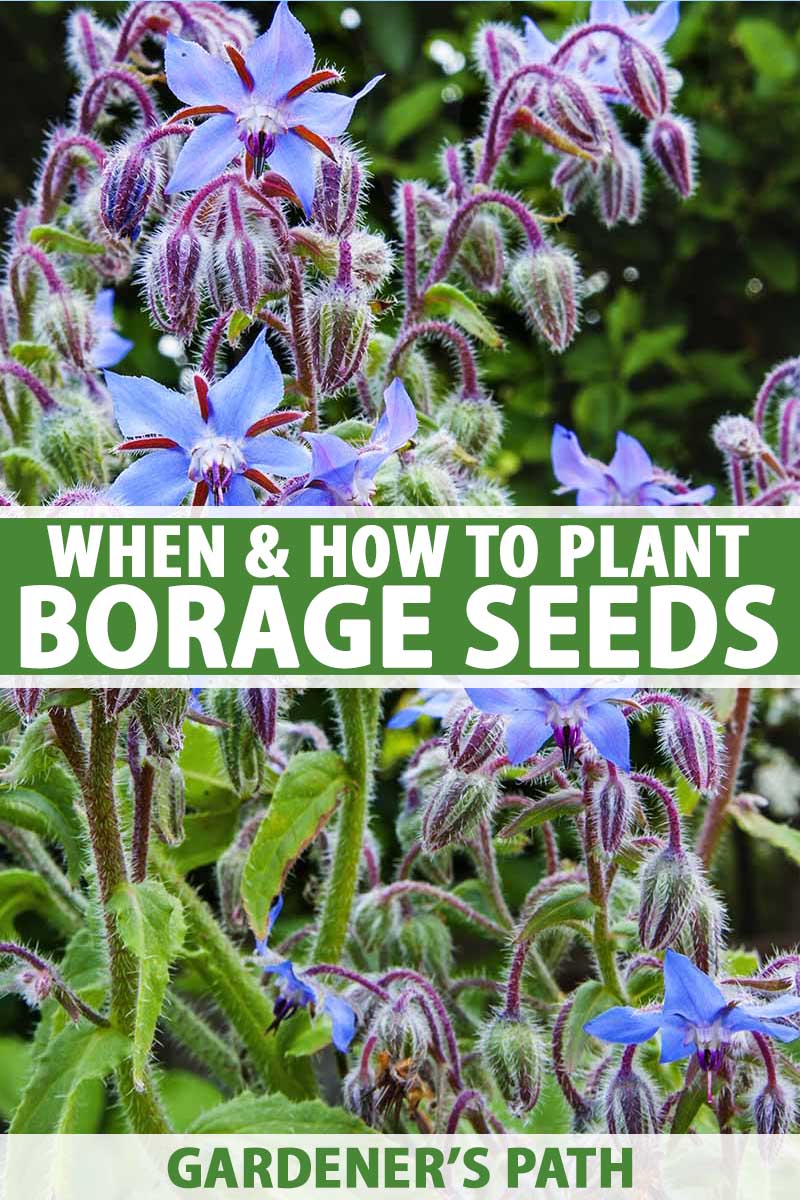
We link to vendors to help you find relevant products. If you buy from one of our links, we may earn a commission.
Of course, that doesn’t mean that there aren’t a few things you should know, but this article will give you all the details (and then some!).
Here’s what I’ll cover:
What You’ll Learn
A Bit About Borage
Borage, Borago officinalis, is an annual herb in the forget-me-not, or Boraginaceae family that has naturalized across most of the United States.
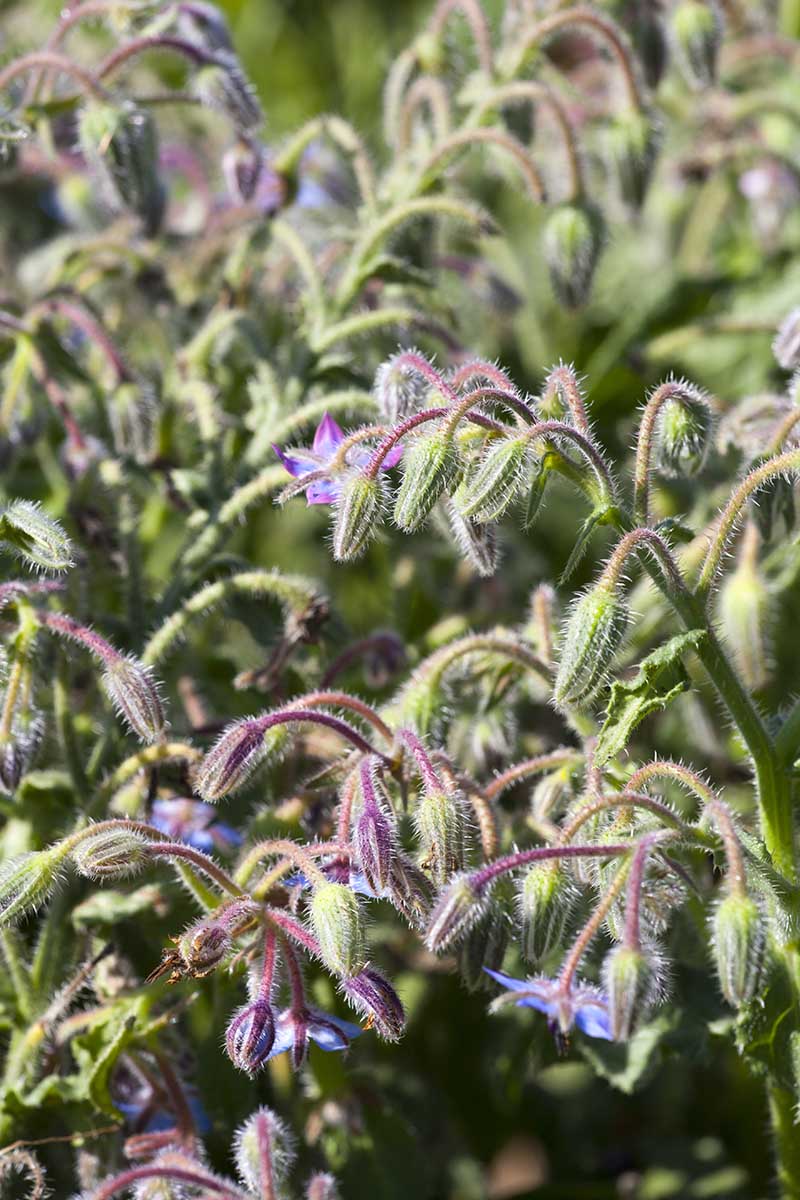
Native to the Mediterranean region, it has made a name for itself far and wide as a tasty herb with edible flowers that pollinators love.
The flowers and leaves are used in a variety of herbal remedies, and the oil extracted from the seeds is high in gamma linolenic acid, which may help to reduce inflammation and alleviate symptoms of asthma.
It’s not only valuable in the kitchen and the medicine cabinet, but it can also be used in the garden as a cover crop to suppress weeds, help retain water, and enrich the soil.
Borage grows just about anywhere, and that’s only a slight exaggeration. It thrives in full sun to part shade locations, in containers, or spreading out in a meadow.

It’s suitable for gardeners in USDA Hardiness Zones 2 to 11 and isn’t too demanding when it comes to moisture or soil – which is why it pops up in sandy and clay soil alike. So long as it doesn’t have wet feet, borage will be happy to do its thing.
The plant features beautiful, bright blue flowers that have a distinct star shape. There’s also a cultivar available with stunning white flowers.
The stems are covered in fuzz and have a deep red color when they’re young. Plants grow to a mature height of about two feet.
Preparation
Before you sprinkle your seeds into the soil, you need to do some prep work.
It’s easiest to sow borage seeds directly into the garden – in a full sun or part shade location – but you can start them indoors if you want.

While borage isn’t too fussy, it does require well-draining soil. You may need to work in some well-rotted manure, compost, peat moss, or sand into the soil to improve drainage.
You can also use some well-rotted compost worked into the top 12 inches of the soil to give your borage babies a boost of nutrients and to loosen up the soil.

If you’re planting in a container, make sure it’s at least 12 inches wide and deep, to accommodate the taproot, and that it has at least one drainage hole at the bottom.
If it has been used before, clean your pot with one part bleach to 10 parts water. Add a well-draining potting soil.
If you’re starting seeds indoors, use six-cell jumbo plug flats or three-inch pots. You need something large enough so that the long roots have room to spread out as they grow.
I like to use biodegradable pots with a seed starting mix so I don’t have to disturb the taproots.
But borage is resilient enough that you don’t have to worry too much as long as you take a little care when transplanting.
Where to Buy Seeds
You can usually find seeds available at your local garden center or nursery. Make sure you buy them from a reliable source to ensure the seeds are viable.
Borage Seeds, Available at Eden Brothers
Seeds are available from Eden Brothers in a variety of packet sizes.
You can also find a variety with white flowers, also at Eden Brothers.
When to Sow
Start seeds outdoors in the spring when all danger of frost has passed, or start them indoors three to four weeks before the last frost.
Borage only takes about eight weeks to mature, so you can succession plant all summer long as long as you have eight weeks before the first frost.
Just keep in mind that it will bolt and go to seed more quickly in hot weather.
How to Sow Seeds
Borage seeds should be planted 1/4- to 1/2-inch deep, so you can either poke a hole and plop in a seed every 12 inches, or take the easy route and sprinkle seeds on the soil.
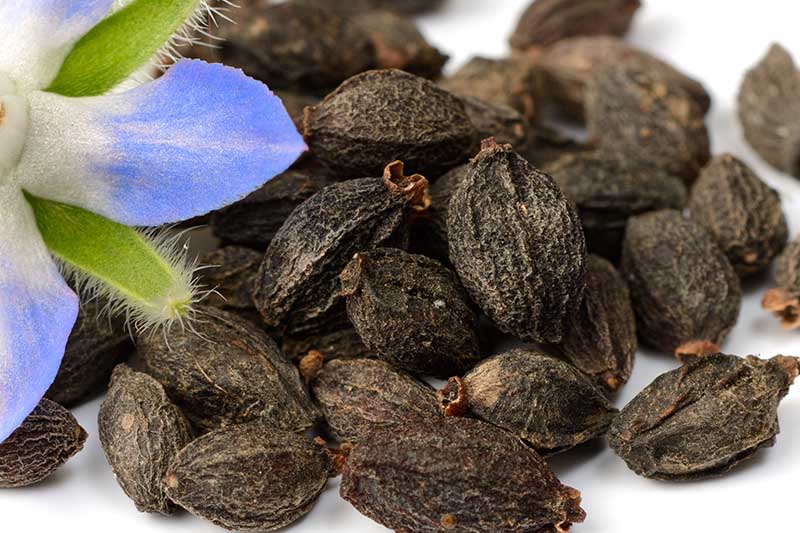
Then, cover with a layer of soil and gently press it down.
To start indoors, sow one or two seeds per seed cell, and cover with soil.
Water the soil carefully so as not to disturb the seeds. I use a water bottle if I’m sowing indoors. Outdoors, I use a fine-spray hose head.
Before they germinate, you want to keep the soil moist but not waterlogged. The soil should feel slightly damp and stick together, but you shouldn’t see any water drip out if you give it a squeeze.
In about a week, sometimes up to two weeks, you should start seeing seedlings stick their heads out of the ground.
Initially, you’ll see a pair of shiny, wavy cotyledons appear. Later, you’ll start to see the true leaves emerge. These are hairy and have a matte, rough texture.
Once you see the true leaves, you can ease up on watering. That means you can allow the soil to dry out on the surface in between spritzes.
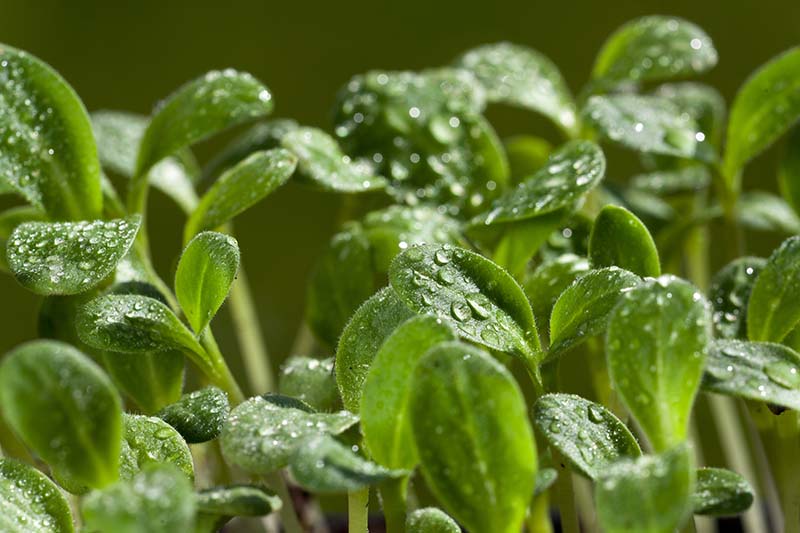
In my experience, borage seeds have a high germination rate, so you’ll likely need to thin them out.
If you started your plants indoors and planted more than one seed into the containers, thin them out to one plant per pot when they have at least one set of true leaves.
Just pluck out the weaker, thinner, or shorter plants and leave the strongest behind.
If you sprinkled seeds outdoors, you’ll need to thin plants to 12 inches apart when they’re about six to eight inches tall.
Transplanting
If you started your seeds indoors, you can transplant them into the garden when they are six to eight inches tall, and all danger of frost has passed.
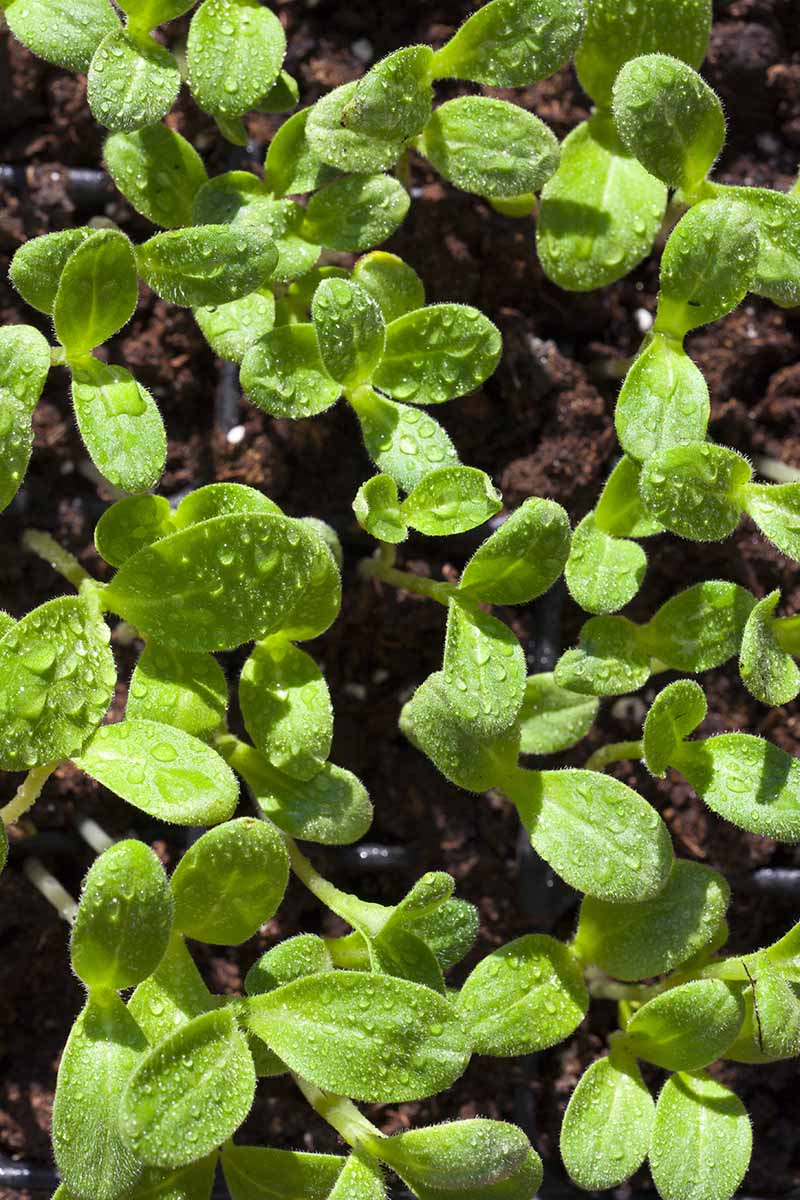
Harden them off by moving your seedlings into a sunny spot outdoors, and gradually increase the amount of time they spend outside over the course of a week.
Then you can plant them in the ground.
Dig a hole in the prepared soil or container, and carefully place one plant every 12 inches.
If you are not using biodegradable pots, remove the seedling gently from its container, to avoid damage to the roots.
Tamp down the soil and water in well.
Daily Care
Borage won’t complain if you give it part shade, meaning it gets only three or so hours of sun a day, but it will grow faster and bloom more profusely in full sun.
I planted borage from seed in late April in a sunny spot and you can see how happy the plant was by mid-June.
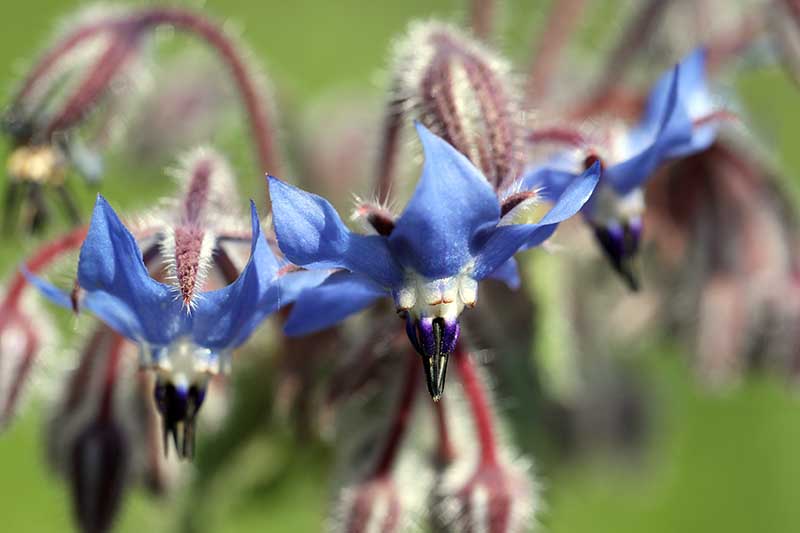
At the same time, I planted some seeds in my “cocktail herbs” container garden.
It’s getting three hours of sun a day, and the plant is a little leggier and about a week behind blossom-wise than my full sun borage.

That said, the leaves of both taste delicious, so it all depends on your goals.
The plants need regular water, but you can let the soil dry out a little between irrigation. When the top two inches of the soil feel dry, it’s time to top things off.
Growing Borage is a Self Esteem Boost
There’s something to be said about a plant that feels like a bit of a vacation compared to some of the more fussy plants out there.
Of course, I love the challenge of gardening, but sometimes you want a plant that you can grow from seed without it feeling like you’re waging an uphill battle.
Obviously, there’s a lot more to love about borage than its relative effortlessness. The flavor alone makes it worth the minimal effort.

I’m not crazy about cucumber, and borage often gets compared in flavor to the cucurbit, but I love this fuzzy green. It has a more complex, saltier taste that I can’t get enough of.
During the summer months, I love to sit outside and watch the bees flit around the borage patch. It seems to attract the local pollinators more than just about any other plant.
Have you grown borage from seed? Let me know in the comments below!
If you want to know more about growing borage in your garden, check out these articles next:
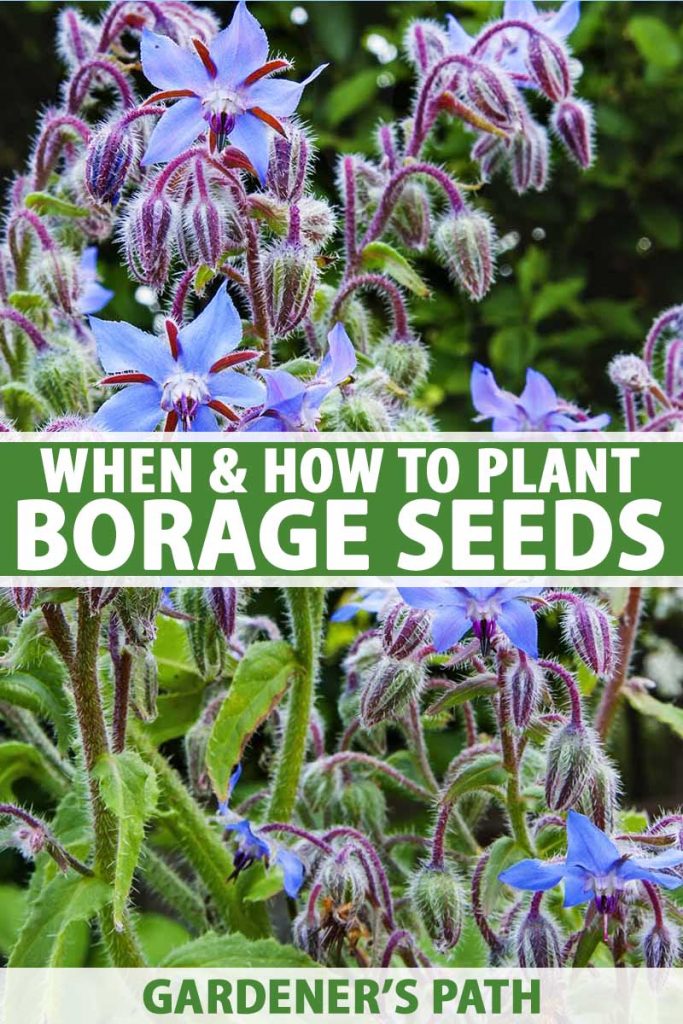
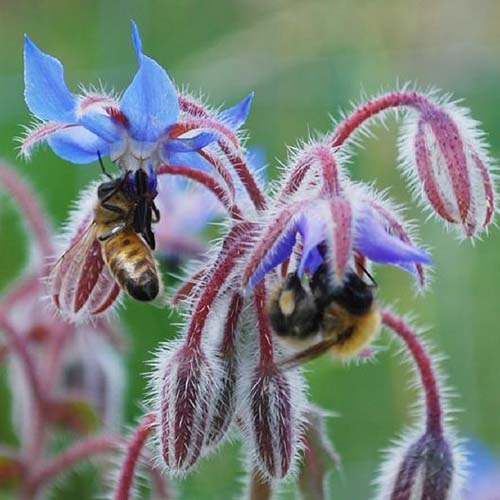
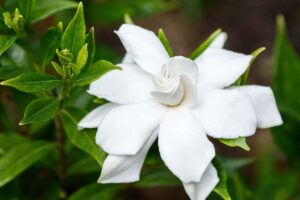
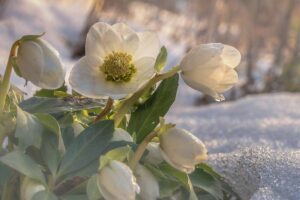

Saw a bunch of volunteer borage from last year’s plants this AM in the garden–looks very robust. It is going on July and there are no flowers, but copious buds look like they are about to bloom (section 5b or 6). Some seed-planted borage from this year nearby looks very similar–must be a good spring/summer for it! The borage plants ring a 4×8 inground bed with very productive tomato plants and a line of potatoes just beginning to flower. I just like having them around in addition to all the edibleness and other good features–insect foci when in full bloom!
Your borage – and entire garden – sounds so happy! Most of mine are in full bloom right now (Zone 8b) – even my shady potted plants are opening up. I could never eat all the borage I grow, but I love having it around because it makes the insects so happy.
Just a little fun fact to add to your Borage info.. Not only is this plant ally good for the respiratory, GI, adrenal, rheumatic pain and other systems, but this beauty was also known to give courage. Makes sense since it strengthens our adrenal system (adrenaline) . I’ve learned that in medieval times the flowers were embroidered on the knights’ cloaks to give them courage. Borage was put into the Knights’ drinks as they left on their journeys. Borage was also sneaked into the drinks of prospective husbands to give them the courage to propose (Mars, 2007)! Plants are so… Read more »
Fascinating! I had no idea about borage and courage. Thanks for sharing.
Thanks for the most informative discussion on borage that I have seen so far. My hand seeded have just emerged and I am so anxious for true leaves. Hoping it attracts pollinators like my clustered white mountain mint which is a pollinators magnet and requires zero care here in Georgia
Happy that our guide was informative! Good luck with the borage, I find mine to be exceptionally carefree and the bees/butterflies love it.
I am in Chicago and the planting season is not going to be here for a while. But my tent-grown borage is looking healthy. Are there any recipes that you have tried and love that have borage in them?
Isn’t it wonderful how hardy borage is? I particularly love it with fish and in salads. I like to steam the leaves or sauté them in butter and use them as a side or bed for white fish or scallops. You can’t go wrong using the flowers in salads. I also recently made a chimichurri with borages leaves and it was fantastic. Just use your favorite chimichurri recipe, but substitute borage for the greens (usually parsley).
Just started some borage from seeds my son got at school. So far two little heads are poking up…I feel super accomplished, lol.
Congrats and enjoy!
Hi I loved this article about Borage. I never heard of them but read a lot about them over the winter found some seeds at a local vendor started inside they are thriving outside transplanted about 2wks ago. I have a Urban Garden- 4yrs ago was my 1st time growing anything! Now I have a incredible urban garden here in our city everyone comes to see. It’s not huge or Home & Garden showcase but it’s beautiful & shows everyone Yes you can grow in the city! I live in a Brownstone type building 1st floor we have vegetables &… Read more »
How cool! Sounds like you have a green thumb and are making the most of that short growing season. Thanks for sharing and your kind words!
Thank you for a elaborate article on borage. I am about to seed them in my garden. There are no bees in our area. Do you think it’s magic will work and attract 🐝 in my area?
Hi Vasudeva, if there are bees within a mile or so, I wouldn’t be surprised if they find their way to your borage. I’ll cross my fingers!
Do all borage plants get flowers?
I planted several seeds in a full sun area but only one plant has flowers
Yes, all borage plants should flower. If they aren’t, it’s usually due to something like a lack of sun, not enough water, too much nitrogen in the soil, or too much water.
In Iranian culture, back In the day borage tea was served to people who went into some kind of shock or are grieving or are in some kind of emotional malaise… And it helped them tremendously. My grandmother would always make me it’s tea during my periods as I was always on the heavy bleeding side and by next day my periods would almost go down to spotting.. It also helped me calm down my mind and emotions.
Thanks so much for sharing, Najmeh! My favorite medicinal plant book highly recommends borage tea. I’ll have to give it a try next time I’m having a rough day. This year, I’m growing white borage, and it has an ever-so-subtle flavor difference from the purple that I’m really enjoying.